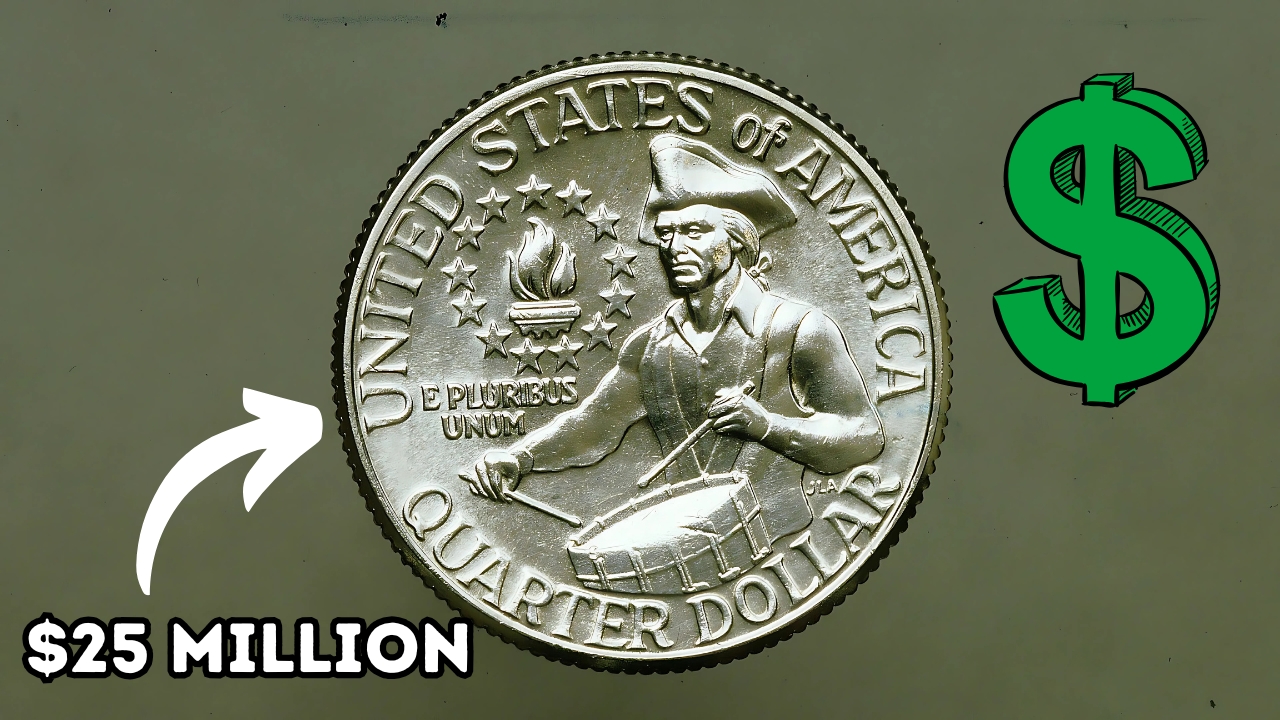Rare Bicentennial Quarter : Nestled in the everyday change in cash registers, coins jars, or even your own pockets could be hiding one of the most remarkable modern treasures in numismatics—a unique variety of the Bicentennial quarter potentially valued at a staggering $25 million.
This assessment is not exaggerated; it represents the legitimate value of a spectacular minting error that has managed to evade collectors while possibly circulating in typical transactions across the United States.
The United States Mint produced these commemorative Bicentennial quarters from 1975 to 1976 to mark the 200th anniversary of American independence.
These distinctive quarters showcase a colonial drummer on the reverse and feature the dual dates (1776-1976) on the obverse.
Despite their unique design, over 1.7 billion of these quarters were minted, making them relatively common even today.
Among the many minted, however, lies an exceptionally rare variant—so rare that only a few examples are believed to exist, with just one confirmed instance recognized within the numismatic community.
The $25 Million Error: What Makes It Special
The priceless quarter stemmed from a minting error known as a “double-die obverse” combined with a unique overdate error linked to its Bicentennial design.
In simpler terms, the die employed to strike the coin was accidentally impressed twice at slightly varying angles, resulting in a subtle doubling effect noticeable on Washington’s profile—especially around the date and lettering.
What elevates this specific error coin’s value dramatically above other typical double-die quarters is the following unique combination of elements:
-
The error is exclusive to the special Bicentennial design
-
The notable doubling is most apparent on the dual dates (1776-1976)
-
The coin was struck on a copper-nickel planchet rather than silver
-
The error happened at the Philadelphia Mint (with no mint mark)
According to Lawrence Shepherd, a distinguished numismatic expert focusing on American coinage, “This represents a perfect storm of error coin circumstances.”
“It combines a historically meaningful commemorative design with a major minting error that somehow passed quality control during an era of heightened public passion for coin collecting.”
Rare Bicentennial Quarter Verification Challenges and Authentication
Given the staggering value linked to this specific error, challenges in authentication have become widespread.
Many collectors have claimed to own the rare quarter, yet almost all examples sent in for professional appraisal have turned out to be either modified coins or manifestations of machine doubling—an occurrence resembling, but distinctly different from, an authentic double-die error.
The Professional Coin Grading Service (PCGS) and the Numismatic Guaranty Corporation (NGC), the leading organizations in coin authentication, maintain stringent standards for verifying prospective examples.
Both organizations employ advanced microscopy techniques alongside comparative analysis against known characteristics of the confirmed piece.
Maria Santiago, a senior authenticator at PCGS, states, “We review hundreds of Bicentennial quarters each year, seeking true examples. The authentic coin exhibits specific doubling traits that cannot be replicated after the minting process.”
“The doubling is notably visible on the ‘776’ in the dual date as it consistently maintains elevation across the affected elements.”
Rare Bicentennial Quarter Still in Circulation: The Ongoing Hunt
Compellingly, additional instances of this extremely rare error might still be floating around in everyday commerce.
In contrast to other valuable coins that were swiftly taken from circulation due to their silver content or distinct appearance, the Bicentennial quarter error resembles regular quarters at first glance.
Coin roll hunters—enthusiasts searching through bank-wrapped rolls for valuable finds—have prioritized the Bicentennial quarter in their quests.
Online communities dedicated to this search encompass thousands of members who inspect millions of quarters each year.
Robert Finkelstein, the founder of the American Rare Coin Fellowship, remarks, “Most significant coins from the 20th century left circulation decades ago. This particular quarter could be considered one of the last great ‘buried treasures’ hiding in plain sight. Its value keeps escalating due to its elusive nature and a growing interest among collectors.”
Rare Bicentennial Quarter What To Look For
For individuals hoping to find numismatic treasure, experts suggest inspecting any Bicentennial quarters with the following distinctive traits:
-
No mint mark (indicating it originated from the Philadelphia Mint)
-
Visible doubling on the date, focusing particularly on the “776” segment
-
Doubling observed in “LIBERTY” and “IN GOD WE TRUST”
-
Standard copper-nickel coloration (not silver)
Experts warn that genuine verification requires professional examination.
With potential values soaring into the millions, the market unfortunately sees a significant number of altered coins and outright fakes.
For the average person, this hunt represents an exciting opportunity—exploring pocket change that could potentially be of life-changing value—a modern treasure hunt available to anyone willing to scrutinize their quarters meticulously.
